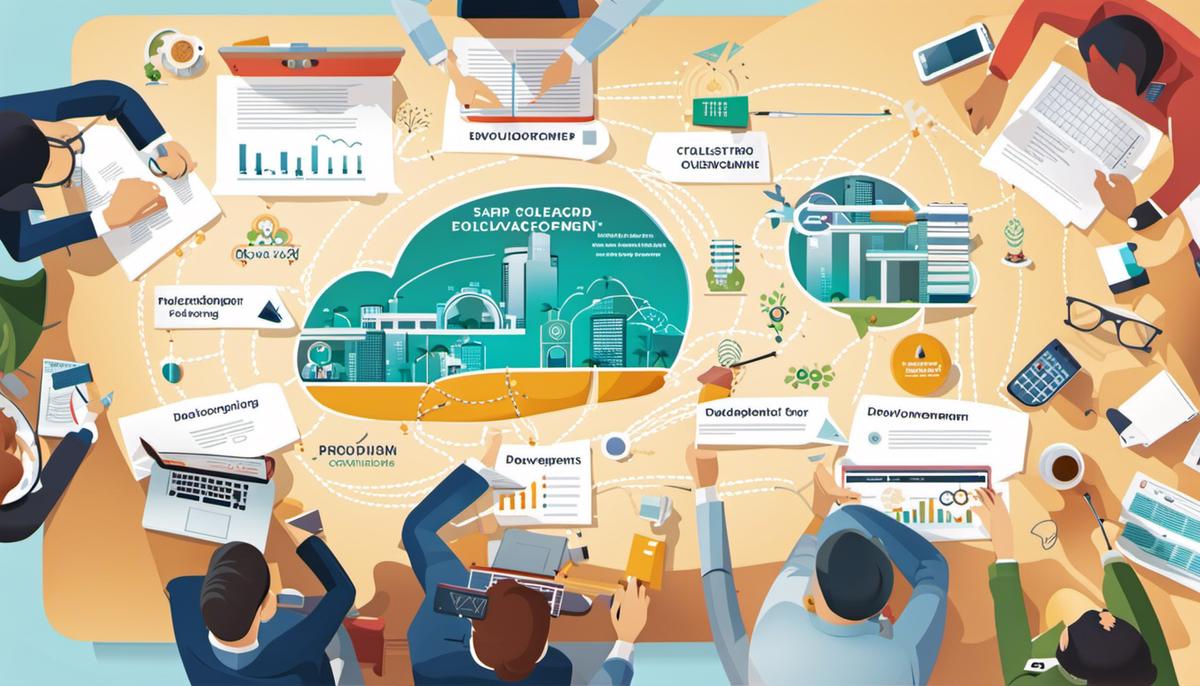Leadership, team management, and effective communication are indispensable components of building high-performance product teams. Together, they create an atmosphere conducive to collaboration, innovate thinking and ultimately transformative creations. Moreover, a comprehensive understanding and execution of the product development process can greatly influence the product’s success. This discussion delves into the integral roles of effective communication, highlighting its pivotal contribution to team cohesiveness, the impact of leadership styles, and team management on overall productivity, and the insightful mastering of the agile product development process, which all commingle to construct high-performance product teams.
Effective Communication
The Value of Clear & Effective Communication in Product Teams
Clear and effective communication is the cornerstone of building a high-performance product team. In the fast-paced world of product development, misunderstandings can result in costly errors, missed deadlines, and the failure to produce a product that meets customer needs. With clear communication, teams can ensure that all members share the same understanding of project goals, customer requirements, and task assignments.
Overcoming Miscommunication, Encouraging Clarity
Active listening and idea sharing are key actions that promote effective communication among team members. Teams should encourage each member to ask questions to clarify any ambiguities and to share ideas freely. This fosters an environment where everyone learns from one another and can contribute their knowledge and expertise towards achieving the team’s goals.
Enhancing Collaborative Efforts Through Clear Communication
Effective collaboration is another byproduct of clear and effective team communication. A shared understanding of tasks, responsibilities, and timelines removes ambiguity and facilitates greater collaboration among team members. This in turn leads to a more organized and efficient team, capable of producing high-quality products on schedule and within budget.
The Use of Tech Tools for Effective Communication
Recognize the importance of modern communication tools in facilitating effective team communication. Platforms like Slack, Microsoft Teams, Zoom, or Google Meet offer features that can enhance and simplify communication among team members. For instance, these tools can facilitate simultaneous communications, store past communications for future reference, and schedule future tasks or meetings.
Feedback: An Essential Component of Effective Communication
Feedback should be a consistent part of team communication, ensuring that the work aligns with the project’s goals and standards. Regular feedback sessions allow for real-time updates and improvements, reducing the possibility of costly mistakes while keeping the team’s performance on the right track.
The Impact of Clear & Effective Communication on Team Performance
In conclusion, clear and effective communication plays a vital role in the success of a high-performing product team. It promotes shared understanding, supports collaboration, effectively uses technology, and encourages ongoing feedback. By prioritizing clear, concise, and effective communication, product teams can achieve their goals and deliver exceptional products that meet their customers’ needs.

Team Management and Leadership
Understanding Leadership Styles in Team Management
Various leadership styles exist and they could impact the performance and productivity of an organization. Firstly, the transformational leadership style focuses on inspiring teams to surpass their potentials and achieve high standards. Secondly, transactional leadership operates designated tasks and rewards based on performance. Lastly, laissez-faire leadership gives team members the freedom to make decisions.
Embracing Company Culture for High Team Performance
Creating a positive and conducive company culture is vital in building high-performing teams. It encourages open communication and collaboration among team members, boosting their morale and dedication towards projects. Team leaders should promote core values and create an environment that fosters learning, inclusivity, and creativity.
Applying Effective Communication Strategies
Clear and consistent communication is key to team management. Leaders must be able to effectively communicate roles, responsibilities, and expectations to their team members. Regular update meetings, providing constructive feedback, and creating a safe space for team members to share their ideas are essential.
Promoting Employee Engagement and Motivation
Increasing employee engagement and motivation can enhance productivity and efficiency. Offering regular growth opportunities, conducting employee recognition programs, or providing competitive benefits can be routes to ensure that employees feel valued and motivated, ultimately increasing performance.
Adopting Agile Methodologies in Project Management
Adopting agile methodologies in team management helps in handling changes swiftly. It allows teams to be flexible, iterate and improve on products continuously. It also encourages collaboration and self-organization within teams which can enhance performance and productivity.
Tracking and Measuring Team Performance
To maximize productivity, team performance metrics need to be trackable and transparent. Regular check-ins to review an individual’s or the team’s performance can help identify any obstacles and devise strategies to overcome them.
Encouraging Collaborative Decision-Making
Encouraging team members to participate in decision-making processes can boost morale and increase job satisfaction. It shows that their contributions are valued, fostering a sense of ownership and commitment to the organization’s objectives.
Implementing Conflict Resolution Techniques
Conflict management is a critical aspect of team leadership. Leaders should be adept at navigating disagreements, fostering a constructive environment where each member’s perspective is heard and respected, and finding resolutions that benefit both the individual employees and team goals.
By understanding different leadership styles, creating a positive company culture, implementing effective communication, and promoting engaged and motivated employees, team leaders can build high-performing product teams. Adopting agile methodologies, tracking performance metrics, involving teams in decision-making, and proficient conflict resolution are further steps to maximizing productivity and performance.

Product Development Process
Understanding the Product Development Process
Product Development Process is a multi-step procedure that businesses follow to conceptualize, design, test, and finally launch a new product in the marketplace. A successful product development process needs to involve a clear roadmap, along with well-defined roles and responsibilities for each team member.
Step 1: Idea Generation
The first step in the Product Development Process is Idea Generation. This is a collaborative process where team members brainstorm potential ideas for the product. This phase could include market research, customer feedback, competitive analysis or the latest trends. All team members play a role in ideation, soliciting feedback and contributing their unique perspectives.
Step 2: Idea Screening
Next, in the Idea Screening phase, the potential ideas are evaluated against your company’s capabilities, market trends, profitability, and strategic fit. Product managers typically lead this phase, with input from team members with expertise in different areas.
Step 3: Concept Development and Testing
Concept Development and Testing is the phase where refined ideas are further developed into actionable product concepts. These are then tested via focus groups, surveys, or feedback sessions. UX/UI designers and product researchers play vital roles in this phase, bringing the conceptual idea to life and testing its market viability.
Step 4: Marketing Strategy Development
A well-crafted Marketing Strategy is the next stage. This includes identifying the target customer, deciding price points, distribution modes, and promotional strategies. Marketing and sales teams play a significant role here, developing the strategy and plans to attract and retain customers.
Step 5: Business Analysis
In the Business Analysis phase, the feasibility and profitability of the product are assessed. It involves market sizing, revenue projection, and profit margin analysis. Financial analysts and business strategists are crucial in this stage, analyzing the potential impact on the company’s bottom line.
Step 6: Product Development
Product Development is the actual creation of the final product. This includes designing, prototyping, and iterating based on the information accumulated so far. Engineers and tech teams play a vital role here, turning the evaluated concept into a tangible product.
Step 7: Market Testing
Market Testing involves testing the product and marketing strategies on a limited scale before the full-scale launch. This helps gauge customer reactions and make necessary adjustments. Responsibly falls on market researchers and the sales and marketing teams for this phase.
Step 8: Commercialization
Finally, in the Commercialization phase, the product is officially launched into the market. This involves full-scale production, distribution and promotion. All team members are involved in this phase, helping to ensure smooth product roll-out and effective communication to target customers.
By ensuring every team member understands their role in each phase, the product development process can be effectively executed and monitored, leading to a high-performance product team capable of consistently delivering successful products.

Building high-performance product teams is a nuanced task, underpinned by effective communication, efficient team management, and a thorough understanding of the product development process. Cultivating a culture of clear, open communication encourages a mutually beneficial collaboration, while strategic leadership and team management nurture optimal productivity and performance. Each phase of the product development process holds unique challenges and requires specific expertise; comprehensive knowledge of each stage ensures a robust, successful product that meets both the client’s and market’s needs. Equipping oneself with these skills is not just a strategic advantage, but a necessity in the current product-oriented business environment.